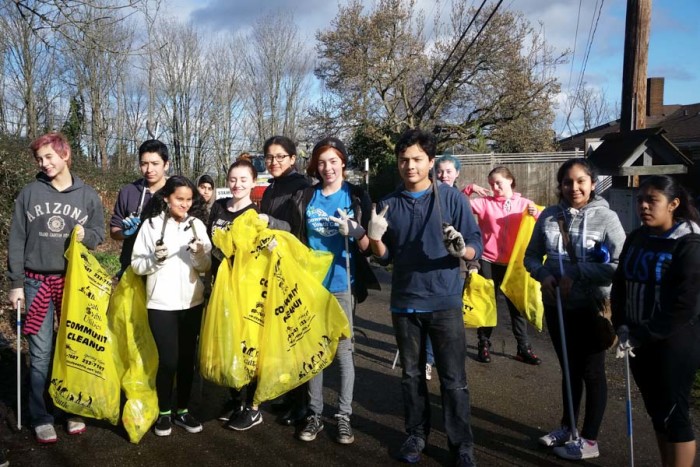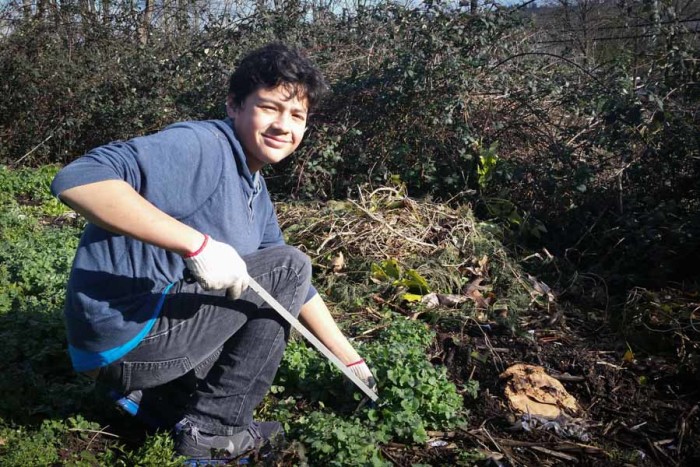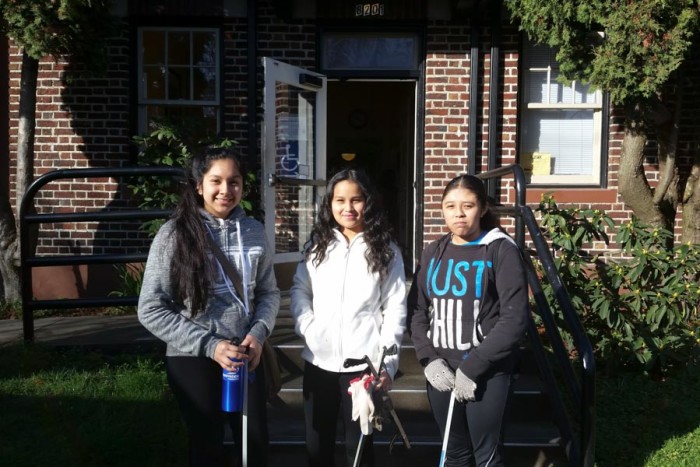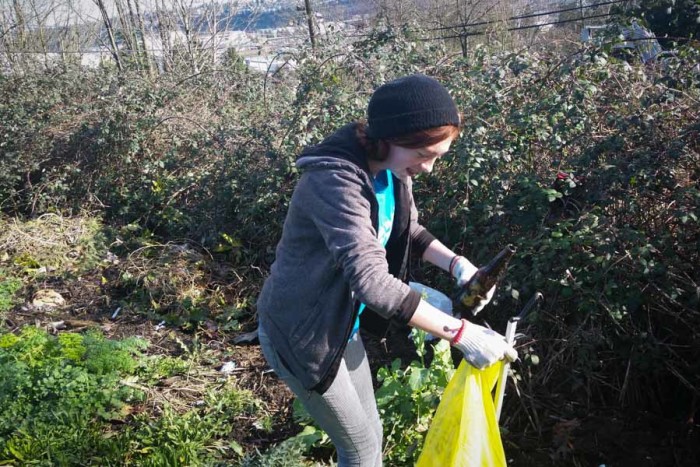
It’s 9 a.m. on a Saturday morning in South Park. The teen participants in the Duwamish Valley Youth Corps (DVYC) are chatting over breakfast as Program Director Carmen Martinez leads them in a quick reminder lesson.
“Now what ends up in the river?” Carmen asks.
The teens respond: oil, dog poop, plastic bags. Anything that goes down the storm drains can end up in the Duwamish.
The group of a dozen young South Park and Georgetown residents are halfway through a ten-week program that’s part environmental education, part hands-on community service, and part job training. They gather twice a week in a makeshift classroom in the basement of the South Park Neighborhood Center to untangle the complex ways environmental injustice impacts their lives.
Their neighborhoods sit along the Duwamish River, one of the most polluted and toxic rivers in the country.
When the river was classified as a Superfund site by the EPA in 2001, it sparked the creation of the Duwamish River Cleanup Coalition/Technical Advisory Group, the organization behind the youth corps program.
The overlap of pollution and poverty is evidence of the inequity facing residents in South Park and Georgetown. Half of the residents in South Park are foreign born, predominantly either from Latin America or Asia. Local Vietnamese men fish in the river for their families, even though the fish are contaminated with heavy metals. Residents have higher asthma rates, connected to low air quality from industry and nearby transit corridors. They have a life expectancy 13 years shorter than in wealthy Seattle neighborhoods.
The teens in the Duwamish Valley Youth Corps are taking these problems head on.

Fernando Buitran smiled as he told me about a project they’d done the week before clearing out a community greenhouse that’s about to receive 4400 seedlings that will be sprouted and transferred to the nearby Marra Farm. Come harvest time, the food will be brought directly back here to the food bank, which feeds over 700 families a week.
The youth plant trees in the neighborhood alongside Urban System Design’s DIRT Corps job training program to help improve air quality.
In addition to improving air quality and growing food for the community, the teens do a lot of litter cleanups. Take the story of the “scary trail” turned “happy trail.” The 8th Avenue trail runs through the South Park neighborhood and is the main path for some kids to get to school, and for families to reach the community center and food bank.
“Before, we called it the scary trail because people on drugs, homeless people, gang members would hang out there,” DVYC participant James Suggs told me.
“It was full of trash,” Fernando chimed in, “so we cleaned it up ourselves.”
They found dirty diapers, beer bottles, and drug needles. They cut down weeds, painted a brick road yellow, and put up a mural of forest scenery.
“We put the forest mural on the trail so people would see positive things,” said Aldebaran “Alde” Hernandez, a youth mentor in the program.

Hollie Townsend showed me her journal pages from walking around the neighborhood and documenting the good and the bad things she saw. She saw prostitution, gangs, the city waste transfer station, the dirty Duwamish. But she also saw good things like rain catchment barrels, rain gardens, and a community food garden.
As they reflect on the good and bad in the neighborhood, the students focus on the change they can create by becoming environmental activists. Many are changing their own behaviors and also talking friends and family into more environmentally-friendly behavior.
“Before, I didn’t care or know anything about littering. Now I know it damages the river, and so I don’t litter anymore,” said Camila Cano. “I also tell my friends if their car is dripping oil they need to take care of it so it doesn’t pollute the river.”
When Daisy Cortez goes to the park with her family, she reminds everyone, “if we litter, we’re not making South Park better.” She wants to see a cleaner, greener neighborhood, and she knows that she has the power to change behavior through education.
The teens also have a vision of what they want the Duwamish River to be like when it’s cleaned up. Cortez envisions picnics, barbecues, and going fishing. She’s hopeful the water will be clean enough for other activities as well:
“I think everyone in South Park would love to get in the water, especially in the summer,” she said.

If they successfully complete the program, the teens receive a modest stipend. But it’s evident that the payoff is much bigger than just the money.
“During the experience, I’m actually not thinking about getting paid,” Suggs said. “I’m thinking about how other neighborhoods have more than twenty percent of canopy tree cover, and our neighborhood only has three percent.”
In just a few weeks, she has already become an environmental justice advocate and is well spoken in relating the concepts of tree cover to air pollution to asthma rates.
Newer cohorts receive mentorship and support from past graduates, and the younger teens see the job pathways that are being created through the program. Some are interested in starting businesses for building rain gardens and sustainable landscaping. Some are more interested in the social and political opportunities.
Hernandez joined the program originally for the stipend, and now he is a paid mentor, and also has a job with the city’s Youth Employment Program.
“I realized my community needs me and I need it,” he said. “I’m proud of the work we do.”
Click here to get involved with Duwamish River cleanup efforts, or contact Carmen Martinez for info on joining the Duwamish Valley Youth Corps: Carmen@duwamishcleanup.org

